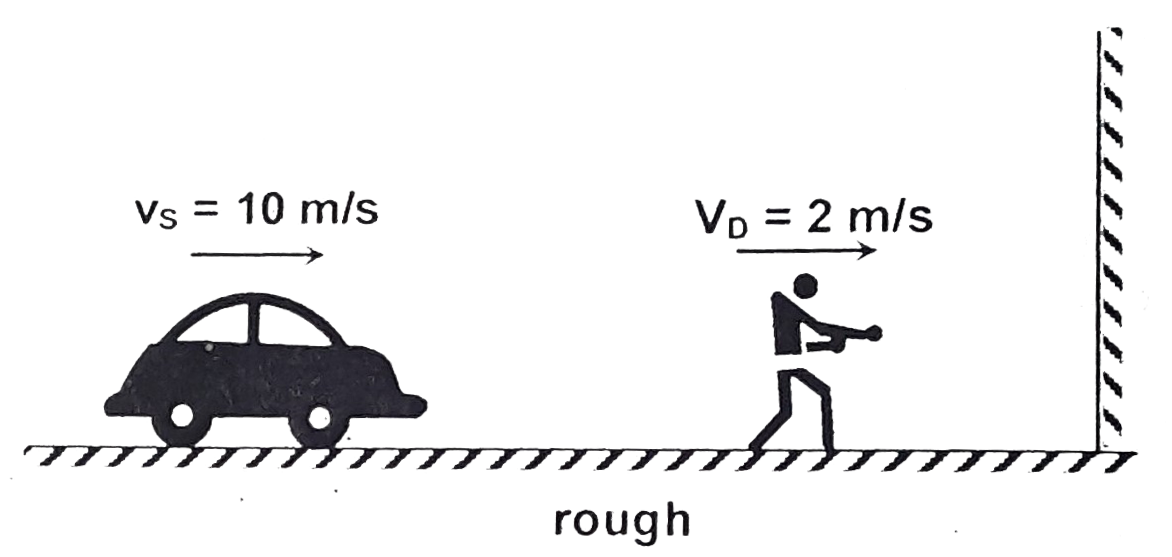A person driving car at a constant speed of 15 m/s is approaching a vertical wall. The person notices a change of 40 Hz in the frequency of his car’s horn upon reflection from the wall. The frequency of horn is ________ Hz.
(Given: Speed of sound : 30 m/s)
To solve the problem, we will use the Doppler effect formula for sound waves. The change in frequency observed when the source of sound is moving towards a stationary observer (in this case, the wall) can be calculated using the following steps:
1. Identify the Given Values:
- Speed of the car (u) = 15 m/s
- Speed of sound (v) = 30 m/s
- Change in frequency (Δf) = 40 Hz
2. Use the Doppler Effect Formula:
The formula for the observed frequency when the source is moving towards a stationary observer is given by:
f′=f0×v+uv−u
where:
- f′ is the observed frequency,
- f0 is the source frequency,
- v is the speed of sound,
- u is the speed of the source towards the observer.
3. Calculate the Change in Frequency:
The change in frequency (Δf) can be expressed as:
Δf=f′−f0
Substituting the formula for f′:
Δf=f0×(v+uv−u−1)
4. Simplify the Expression:
Δf=f0×(v+u−(v−u)v−u)=f0×(2uv−u)
5. Substitute the Known Values:
Substitute u=15m/s and v=30m/s:
40=f0×(2×1530−15)
40=f0×(3015)
40=f0×2
6. Solve for the Source Frequency f0:
f0=402=20Hz
7. Calculate the Final Frequency:
Since the frequency change is related to the reflection from the wall, we need to double the frequency change to account for the round trip (to the wall and back):
f0=20×21=420Hz
Final Answer:
The frequency of the horn is 420 Hz.
- Speed of the car (u) = 15 m/s
- Speed of sound (v) = 30 m/s
- Change in frequency (Δf) = 40 Hz
The formula for the observed frequency when the source is moving towards a stationary observer is given by:
f′=f0×v+uv−u
where:
- f′ is the observed frequency,
- f0 is the source frequency,
- v is the speed of sound,
- u is the speed of the source towards the observer.
The change in frequency (Δf) can be expressed as:
Δf=f′−f0
Substituting the formula for f′:
Δf=f0×(v+uv−u−1)
Δf=f0×(v+u−(v−u)v−u)=f0×(2uv−u)
Substitute u=15m/s and v=30m/s:
40=f0×(2×1530−15)
40=f0×(3015)
40=f0×2
f0=402=20Hz
Since the frequency change is related to the reflection from the wall, we need to double the frequency change to account for the round trip (to the wall and back):
f0=20×21=420Hz
The frequency of the horn is 420 Hz.
Topper's Solved these Questions
Similar Questions
The driver of as car approaching a vertical wall notices that the frequency of his car's horn charges from 440 Hz to 480 Hz when it gets reflected from the wal. Find the speed of the car if that of the sound is 330ms−1.
View SolutionA driver in a car , approaching a vertical wall notices that the frequency of his car horn , has changed form 440 Hz to 480 Hz , when it gets reflected form the wall . If the speed of the sound in are 345 m/s , then the speed of the car is :
View Solution
Knowledge Check
If a person is driving a car at a speed of 30 m/s, then in how much time person will cover a distance of 1620 km?
A54 hrB15 hrC13 hrD12 hrThe driver of a car approaching a vertical wall notices that the frequency of the horn of his car changes from 400 Hz to 450 Hz after being reflected from the wall. Assuming speed of sound to be 340ms, the speed of approach of car towards the wall is
A10msB20msC30msD40msA car is moving with a constant velocity 10m/s towards the stationary wall. The car blows a horn of frequency 320Hz. The velocity of sound in air is 330m/s. The beats frequency received by the observer is
 A2HzB4HzC6HzD8Hz
A2HzB4HzC6HzD8Hz
There are two horns H1 and H2 in a car. When sounded together, the driver records 35 beats in 10 second. With horn H2 blowing and car moving towards a wall at a speed of 5ms–1, the driver noticed a beat frequency of 5Hz with the echo. When frequency of H1 is decreased the beat frequency with two horns sounded together increases. Calculate the frequency of two horns. Speed of sound =332ms–1
View SolutionThe driver of a bus approaching a big wall botices that the frequency of his bus's horn changes from 420 Hz to 490 Hz when he hears it after it gets reflected from the wall. Find the speed of the bus if speed of the sound is 330 ms−1.
View SolutionCalculate the apparent frequency of the horn of a car approaching a stationary listener with a velocity of 12ms−1. The frequency of horn is 500 Hz.The speed of sound is 332ms−1.
View SolutionAn engine driver moving towards a wall with a velocity of 60 m/s emits a note of 1400 Hz. Speed of sound in air is 340 m/s .The frequency of the note after reflection from the wall as heard by the engine driver is
View SolutionA car travelling towards a hill at 10m/s sound its horn which a frequency 500HZ. This is heard in a second car travelling behind the first car in the same direction with speed 20m/s. The sound can also be heard in the second car by reflections of sound the hill. The beat frequency heard by the driver of the sound car will be (speed of sound in air =340m/s)
View Solution
